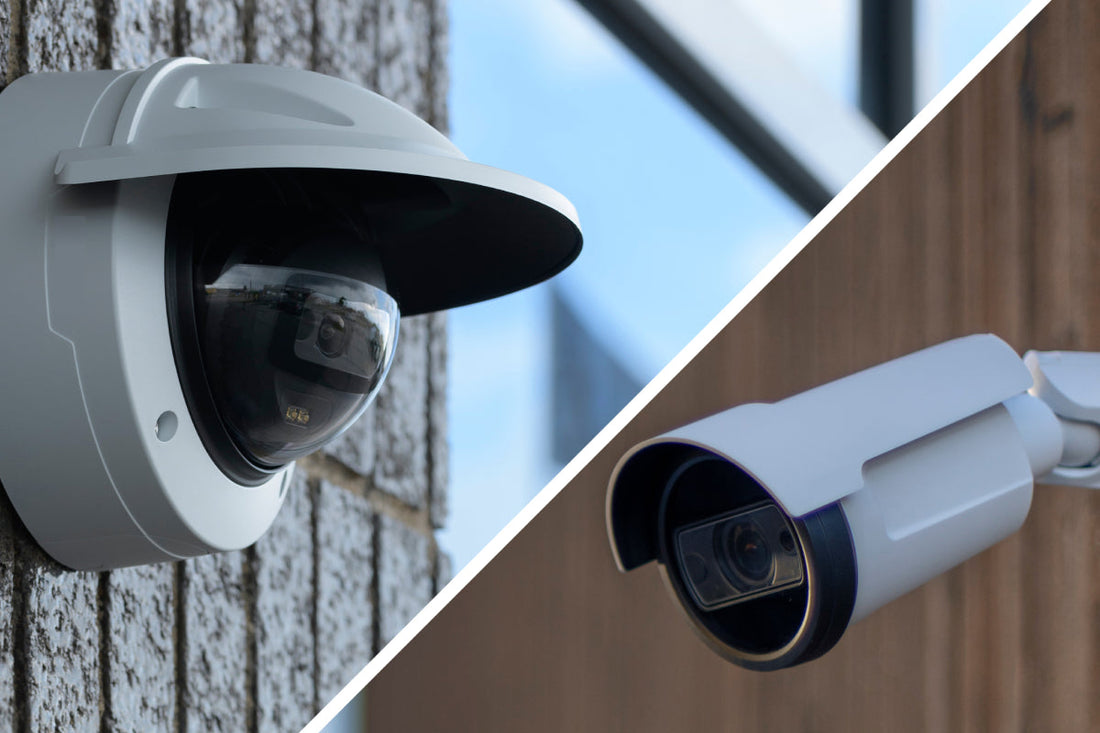
Dome vs. Bullet Cameras: Which Is Best for Your Security Needs?
Share
Understanding Dome and Bullet Cameras: Key Differences for Effective Surveillance
When it comes to protecting your home or business, choosing the right surveillance camera is a critical decision. Among the most commonly used security cameras are dome cameras and bullet cameras. While both serve the same basic purpose—monitoring and recording activity—they differ significantly in terms of design, features, and ideal use cases.
In this article, we’ll break down the differences between dome and bullet cameras to help you make an informed decision based on your unique surveillance needs.
What Are Dome Cameras?
Dome cameras are named for their dome-shaped housing. They are typically compact, discreet, and are often used for indoor or ceiling-mounted applications, although many models are suitable for outdoor use as well.
Key Features of Dome Cameras:
• Discreet Appearance: The compact, rounded design makes them less noticeable and less likely to be tampered with.
• Wide-Angle Coverage: Ideal for covering wide areas like lobbies, retail spaces, or warehouses.
• Vandal Resistance: Many dome models come with vandal-proof casings.
• 360-Degree Rotation: Some offer pan-tilt-zoom (PTZ) capabilities or wide-angle lenses.
Pros of Dome Cameras:
• Less obtrusive and more aesthetically pleasing.
• Harder for intruders to tell which direction it's facing.
• Better protected from tampering and vandalism.
• Suitable for indoor and discreet surveillance needs.
Cons of Dome Cameras:
• Limited range compared to bullet cameras.
• Installation and angle adjustment can be trickier.
• May not perform as well in extreme outdoor weather unless specially designed.
What Are Bullet Cameras?
Bullet cameras are characterized by their long, cylindrical design and are ideal for long-range surveillance, often in outdoor environments.
Key Features of Bullet Cameras:
• Visible Deterrent: Highly noticeable, which can discourage unwanted activity.
• Long Range: Typically have larger lenses, making them ideal for monitoring distant areas.
• Weatherproof: Built to withstand rain, dust, and extreme temperatures.
• Adjustability: Easier to install and manually reposition.
Pros of Bullet Cameras:
• Excellent for long-distance viewing.
• Easy to point and readjust to cover specific angles.
• Durable and ideal for outdoor use.
• Highly visible, which can deter criminal activity.
Cons of Bullet Cameras:
• More prone to tampering due to exposed design.
• Bulkier and less discreet.
• Can be more visually intrusive in certain environments.
Side-by-Side Comparison: Dome vs. Bullet Cameras
| Feature | Dome Cameras | Bullet Cameras |
|---|---|---|
| Design | Compact, dome-shaped | Cylindrical, protruding |
| Visibility | Discreet and less noticeable | Highly visible, acts as a deterrent |
| Installation Areas | Ideal for ceilings or indoor spaces | Great for walls and outdoor use |
| Field of View | Wide-angle coverage | Narrow but long-range focus |
| Durability | Often vandal-resistant | Often weatherproof |
| Adjustability | Limited to pan/tilt or fixed | Easily repositioned manually |
| Best For | Entrances, lobbies, hallways | Perimeters, driveways, parking lots |
Choosing the Right Camera for Your Needs
The choice between dome and bullet cameras depends on several factors:
1. Location
• Use dome cameras for indoor areas or where a wide viewing angle is needed.
• Use bullet cameras for outdoor spaces where long-range visibility is important.
2. Visibility
• If you want to deter intruders, a visible bullet camera is more effective.
• For subtle surveillance, a dome camera blends in better.
3. Mounting Surface
• Ceilings and indoor corners are better suited for dome cameras.
• Walls, poles, or building exteriors work best for bullet cameras.
4. Weather and Tampering Concerns
• Choose vandal-proof dome cameras in areas where tampering is a concern.
• Use weatherproof bullet cameras in harsh outdoor environments.
Conclusion
Both dome and bullet cameras offer reliable security, but each excels in different environments. By understanding their strengths and limitations, you can design a surveillance system that offers maximum coverage, deterrence, and reliability.
Whether you’re securing a small business, a warehouse, or a home, carefully assess your surveillance goals before investing in one or both types. In many cases, a combination of dome and bullet cameras offers the best of both worlds.
Need help designing your surveillance system? Contact us through our website and we will be more than happy to help you out.
